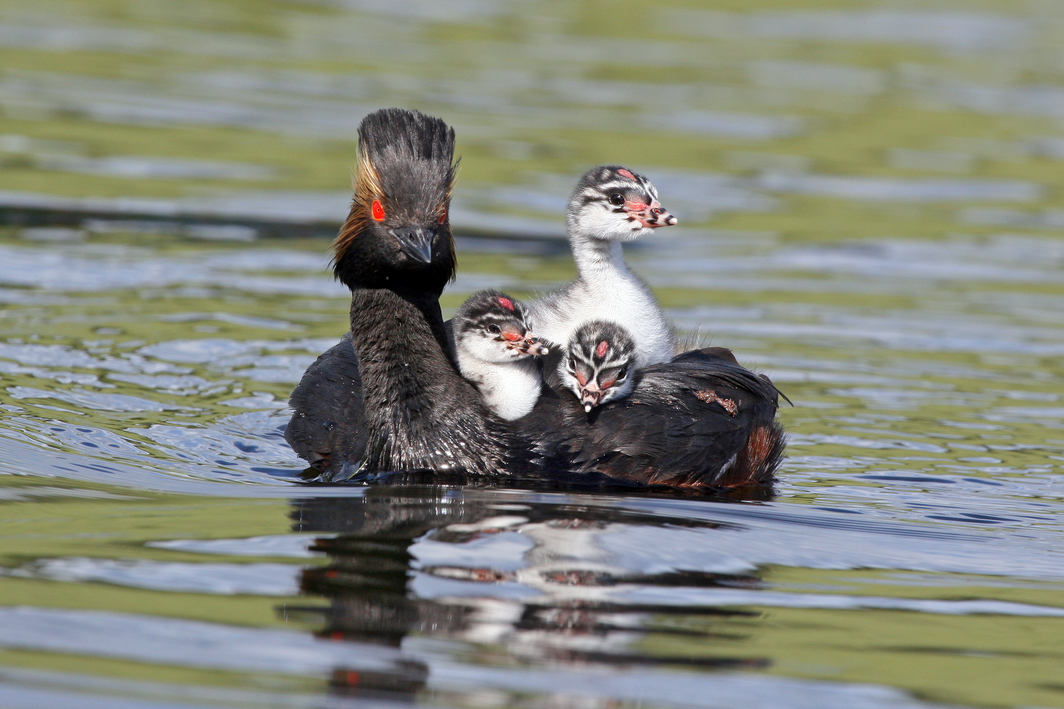Why Some Bird Babies Ride Piggyback
Posted on Categories Discover Magazine

Having your children trail you like ducklings in a pond sounds pretty good to human parents, who are stuck carrying or pushing their offspring through toddlerhood. But some animals with mobile babies choose to carry them anyway. One scientist looked at waterbirds to figure out why certain species find it worthwhile to haul their kids around, while others leave them to paddle alone. The reasons he found range from snuggle time to murderous fish.
Animals including anteaters, bats, primates, seahorses and scorpions carry their young. Brucy Lyon, an ecologist at the University of California, Santa Cruz, is especially interested in aquatic birds called grebes. Most, if not all, grebe species carry their young on their backs.
Lyon started wondering about grebes while he was studying other birds—American coots—in British Columbia. He hid behind a floating blind to study the coots. But, he says, the eared grebes that also swam in this water were “particularly oblivious” to these floating blinds. That gave him a chance to follow the grebes closely and observe them carrying their chicks—something coots never do.
Eared grebes build their nests in colonies, with anywhere from a few to 100 or more pairs of birds nesting together. But once a pair’s eggs hatch, that family leaves its nest for a life on the water. The parents roam around their whole habitat, diving for food and feeding their chicks. Lyon watched eared grebe parents taking turns carrying the young birds on their backs. “Typically, one parent carried the chicks while the other foraged for food to bring to the chicks, and the chicks were fed while they sat on the back of the parent,” he writes, “a floating restaurant of sorts.”
When one parent had had enough of lugging the babies around, it shook the little birds into the water, and they climbed up onto the other parent’s back. The mom and dad carried the babies nearly nonstop for the first week, but less often as they grew larger.
Lyon compared the biology of American coots and eared grebes to try and figure out why this extra parental effort is a good strategy for one species but not the other.
One possible factor is temperature. “Eared grebe chicks’ plumage is not waterproof at hatching and they can only begin to maintain their own body temperature at about 10 days of age,” Lyon writes. Grebe parents keep their chicks warm by tucking them under their wings and back feathers. American coots keep their chicks toasty in their nests, using the more traditional method of sitting on them.
In fact, American coot families are never far from their nests. They live and forage on small territories while their chicks are growing up. Lyon thinks the nomadic lifestyle of eared grebes, combined with the need to keep their babies warm, makes baby-carrying the best plan. Some grebe species spend more or less time carrying their babies; Lyon says his hypothesis could be tested by studying whether species that are more nomadic do more piggybacking.
But that’s still probably not the whole story. Chicks on their parents’ backs are safe from any predators in the water, like fish. That’s right: fish eat birds. A study several decades ago in Canada, for example, found that about 1 percent of northern pike had ducklings in their bellies.
Eared grebes usually live in shallow waters with no fish, Lyon says. But he suspects that predatory fish may be a reason for other grebe species to carry their young. As anecdotal evidence, Lyon notes that a pond near his California home has hosted a pair of grebes and one or two pairs of coots for several years. He’s seen new grebe chicks at that pond every year. But he’s only ever seen one coot chick, which met a grim end: “A small chick emerged from the dense vegetation around its nest, plopped onto the water and was promptly snatched by a bass,” Lyon writes.
He thinks the large-mouthed bass that were introduced to this pond for recreational fishing are gulping down baby birds. Although coot chicks and grebe chicks are the same size, the young grebes are probably protected by riding on their parents’ backs. The coots don’t have the same habit—which, in this case, means they also have no babies.
Image: Bruce Lyon